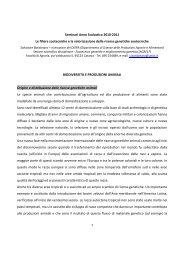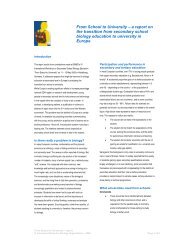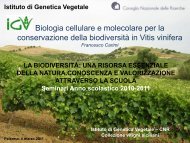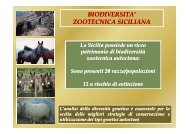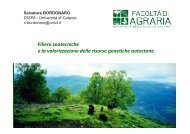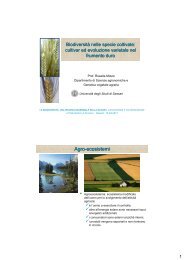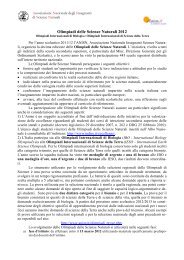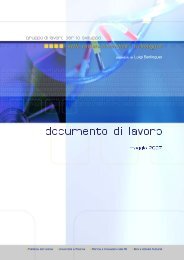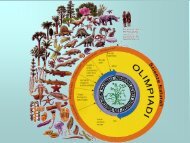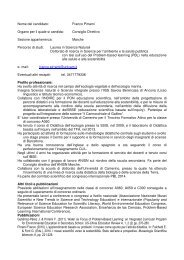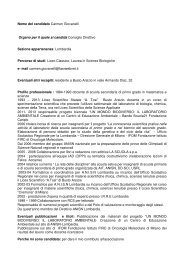L'insegnamento delle scienze nelle scuole in Europa - Indire
L'insegnamento delle scienze nelle scuole in Europa - Indire
L'insegnamento delle scienze nelle scuole in Europa - Indire
Create successful ePaper yourself
Turn your PDF publications into a flip-book with our unique Google optimized e-Paper software.
Ricerche nella didattica e nella formazione degli <strong>in</strong>segnanti di <strong>scienze</strong>Dewey, I. e Dykstra, D.I. (1992) Study<strong>in</strong>g conceptual change: construct<strong>in</strong>g new understand<strong>in</strong>gs. In R. Duit,F. Goldberg e H. Niedderer (Eds) Research <strong>in</strong> Physics Learn<strong>in</strong>g: Theoretical Issues and Empirical Studies (Kiel:IPN) 40-58.Driver, R., Guesne, E. e Tiberghien, A. (Eds) (1985) Children’s Ideas <strong>in</strong> Science (Milton Keynes: OpenUniversity Press).Flandé, Y. (2000) Protocoles expérimentaux, tests d’hypothèses et transfert, Thèse de doctorat, UniversitéParis 7.Flandé, Y. (2003) Le pendule, comme support de tests d’hypothèses. Bullet<strong>in</strong> de l’Union des Physiciens,97(850), 85-102.Galili, I. (1996) Students’conceptual change <strong>in</strong> geometrical optics. International Journal of ScienceEducation, 18 (7), 847-868.Galili, I. e Hazan, A. (2000) Learners’ knowledge <strong>in</strong> optics: <strong>in</strong>terpretation, structure and analysis.International Journal of Science Education, 22 (1), 57-88.Gess-Newsome, J. et Lederman N.G. (Eds) (1999) Exam<strong>in</strong><strong>in</strong>g Pedagogical Content Knowledge (Dordrecht:Kluwer).Glasson, G.E. e Bentley, M.L. (2000) Epistemological undercurrents <strong>in</strong> scientists’ report<strong>in</strong>g of research toteachers. Science Education, 84(4), 469-485.Gilbert, J.K. e Boulter, C. (1998) Learn<strong>in</strong>g science through models and modell<strong>in</strong>g. In B.J. Fraser et K.G. Tob<strong>in</strong>(Eds) International Handbook of Science Education (Dordrecht, Kluwer) 53-67.Goldberg, F., e Otero, V. (2001) The roles of laboratory and computer simulator experiments <strong>in</strong> help<strong>in</strong>gstudents develop a conceptual model of static electricity. In D. Psillos, P. Kariotoglou, V. Tselfes,G. Bisdikian, G. Fassoulopoulos, E. Hatzikraniotis e M. Kallery (Eds) Proceed<strong>in</strong>gs of the Third InternationalConference on Science Education Research <strong>in</strong> the Knowledge Based Society (Thessaloniki: Art of Text) 29-31.Grace, M. M. e Ratcliffe, M. (2002) The science and values that young people draw upon to make decisionsabout biological conservation issues. International Journal of Science Education, 24 (11), 1157-1169.Guilbert, L. e Melloche, D. (1993) L’idée de science chez des enseignants en formation: un lien entrel’histoire des sciences et l’hétérogénéité des visions. Didaskalia, 2, 7-30.Haefner, L.A. e Zembel-Saul, C. (2004) Learn<strong>in</strong>g by do<strong>in</strong>g? Prospective elementary teachers’ develop<strong>in</strong>gunderstand<strong>in</strong>gs of scientific <strong>in</strong>quiry and science teach<strong>in</strong>g and learn<strong>in</strong>g. International Journal of ScienceEducation, 26 (13), 1653-1674.Haigh, M. e Forret, M. (2005) Is ‘do<strong>in</strong>g science’ <strong>in</strong> New Zealand classrooms an expression of scientificenquiry? International Journal of Science Education, 27(2), 215-226.Harlen, W. e Holroyd, C. (1997) Primary teachers’ understand<strong>in</strong>g of concepts of science: impact onconfidence and teach<strong>in</strong>g. International Journal of Science Education, 19(1), 93-105.Häussler, P. (1987) Measur<strong>in</strong>g students’ <strong>in</strong>terest <strong>in</strong> physics – design and results of a cross sectional study <strong>in</strong>the Federal Republic of Germany. International Journal of Science Education, 9(1), 79-92.Häussler, P., Hoffman, L., Langehe<strong>in</strong>e, R., Rost, J. et Sievers, K. (1998) A typology of students’ <strong>in</strong>terest <strong>in</strong>physics and the distribution of gender and age with<strong>in</strong> each type. International Journal of ScienceEducation, 20(2), 223-238.Häussler, P. e Hoffmann, L. (2000) A curricular frame for physics education: development, comparisonwith students’ <strong>in</strong>terests, and impact on students’ achievement and self-concept. Science Education, 84(6),689-705.73



